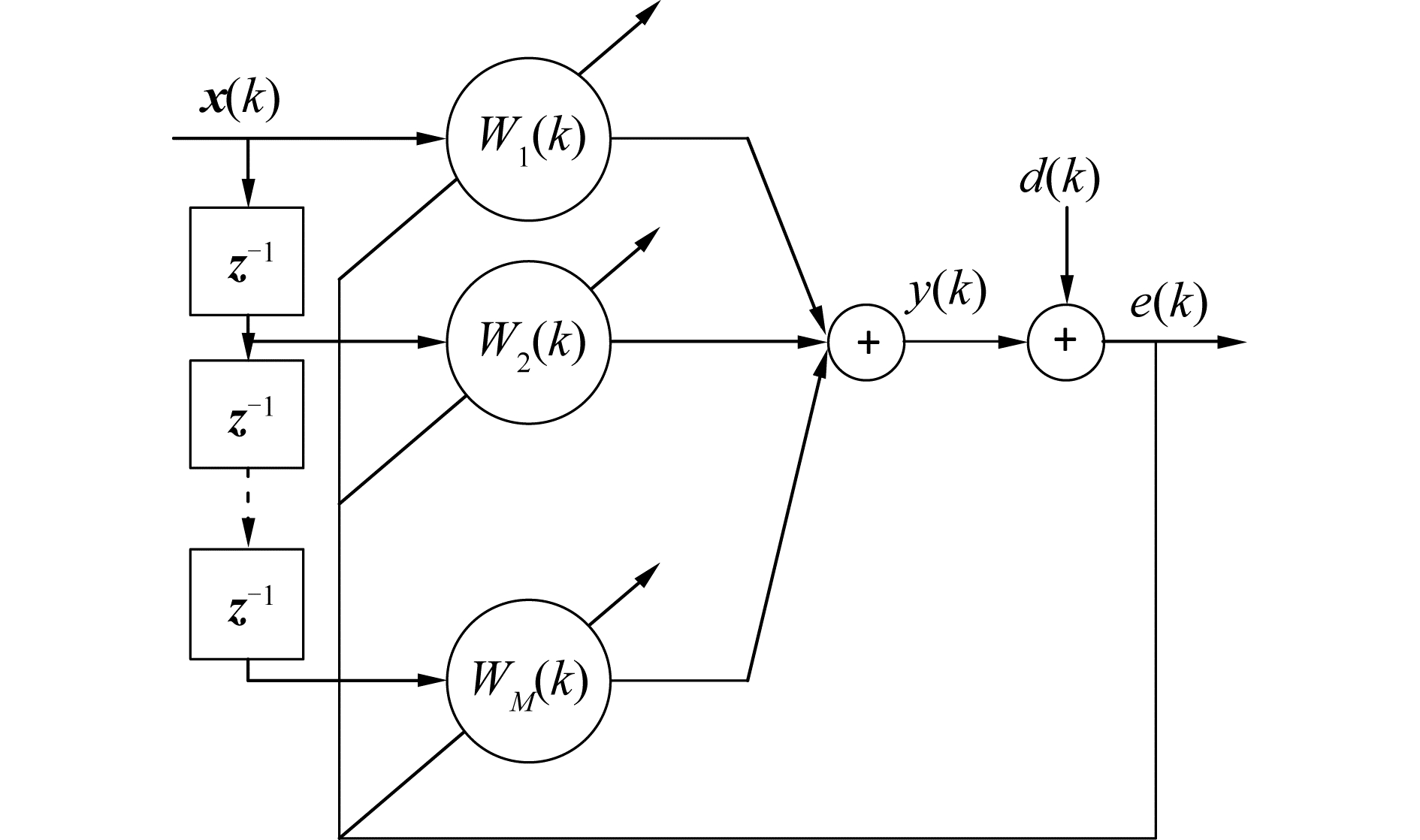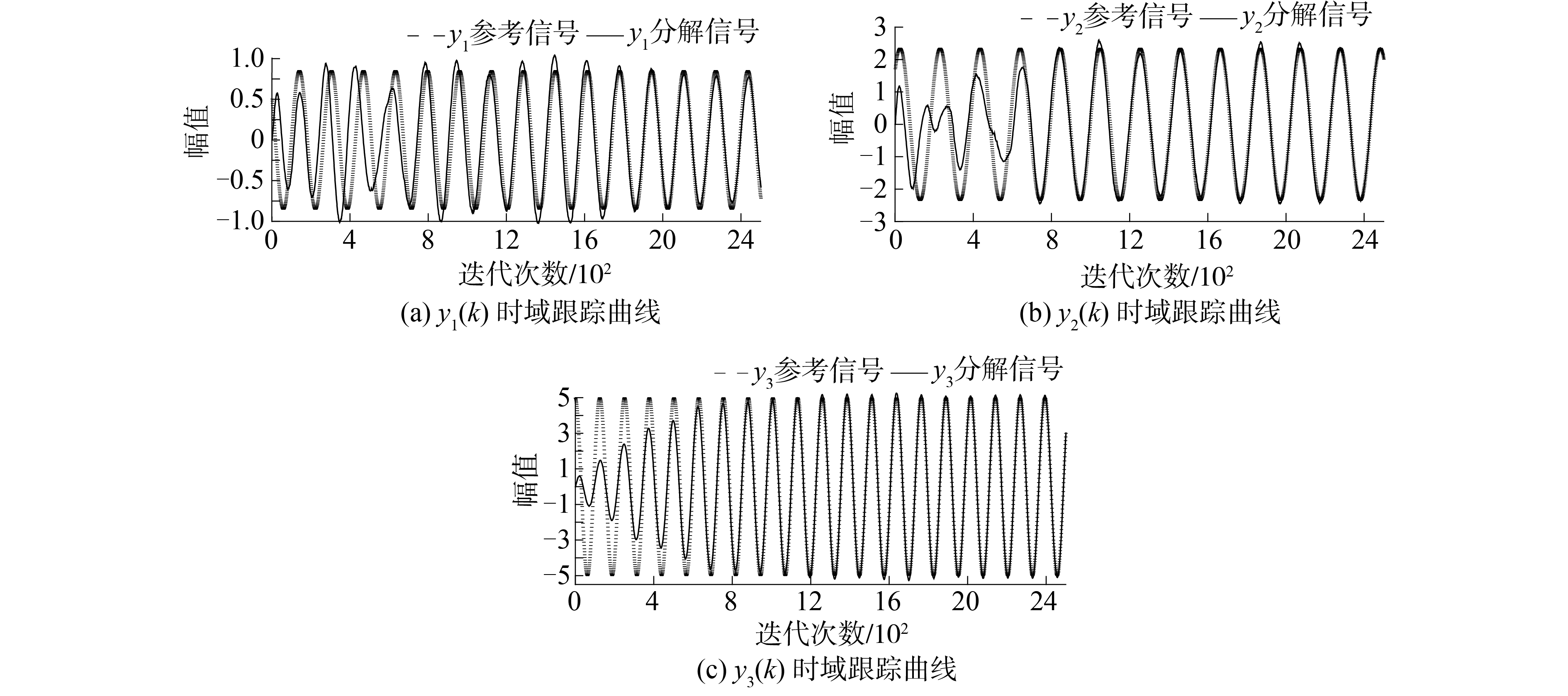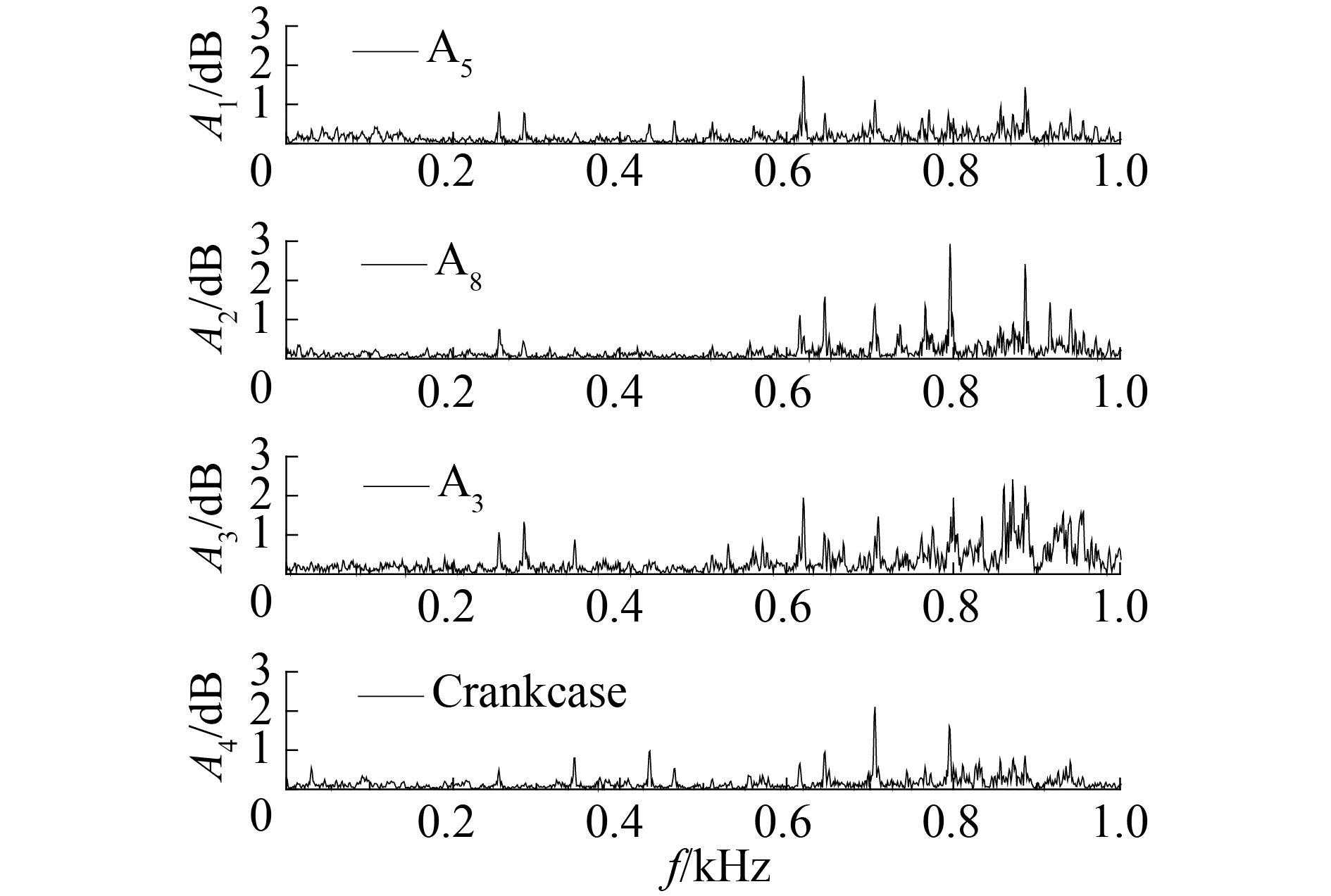2. 哈尔滨工程大学 动力与能源工程学院, 黑龙江 哈尔滨 150001
2. College of Power and Energy Engineering, Harbin Engineering University, Harbin 150001, China
发动机噪声是车辆振动噪声的重要来源,噪声源识别问题,是振动噪声传递通道识别问题的前提,即:在噪声源识别过程中查明、分离噪声源并且识别其源特征;在此基础上提取振动噪声传递、响应及分布等特征,进而识别其振动噪声的主要传递通道[1]。国内外对此都取得了大量研究成果,褚志刚等[2]综合了在平面上声阵列噪声源识别技术波束形成法和平面近场声全息法的优点对某柴油机进气侧进行了噪声源识别;宋宝安等[3]通过台架试验和九点声压法识别系统的主要噪声源;杨洋等[4]利用球面波模型互谱成像函数波束形成理论,针对某柴油机进行声源识别试验,得到其主要噪声源;Yao等[5-6]利用变分模态分解和鲁棒独立分量分析,得到柴油发动机的各个独立噪声,还结合了双耳声定位法和盲源分离法,成功分离柴油发动机不同位置的噪声源;郭海东等[7]结合中值滤波和奇异值分解提出了一种优化经验模式分解方法,并应用在某型涡轴航空发动机振动信号分析中;Blacodon等[8]提出一种三传感器相干法,并对涡轮轴发动机宽带噪声源定位进行了研究;Leclère等[9]利用多通道谱分析对柴油机低频调幅噪声进行了源识别;Dekys等[10]利用短时Fourier变换对机械的退化机理,识别振动源及分析其相互作用;Desante等[11]提出小波变换在柴油机燃烧噪声分析中的应用;Li等[12]提出一种基于独立分量分析的柴油机噪声研究的方法。
然而,考虑实际柴油机振动构成多通道耦合振动系统,存在传递通道耦合及激励信号相关等特点,使得其噪声源分离与识别面临很大挑战,为此本文提出自适应广义线性混合模型算法,进行多点激励单点响应MISO振动系统激励源分析,旨在解决柴油机工作过程中振动噪声分离与识别问题。
1 自适应广义线性混合模型 1.1 广义线性混合模型考虑输入噪声εi服从i.i.d.正态分布, 对于第i个观测值yi,由k个输入序列{xi1 xi2 … xik}线性确定,其满足线性关系:
| $y_{i}=\sum\limits_{k} \beta_{k} x_{k i}+\varepsilon_{i} $ | (1) |
式中βi是待定回归系数。
将随机效应引入线性模型(1),形成含有固定、随机效应的线性混合模型(linear mixed model, LMM)[13],该模型定义为:
| $y_{j i}=\sum\limits_{k} \beta_{j k} x_{k i}+\sum\limits_{k} z_{j k} u_{k i}+\varepsilon_{j i} $ | (2) |
式中:βji是待定回归系数;未知随机效应uji是待定回归系数;随机噪声εji服从i.i.d.正态分布。
设{y1 y2 … yn}来自于指数分布族的随机样本,即yi的密度函数为:
| $f\left(y_{i}, \alpha_{i}, \phi\right)=\exp \left\{\frac{y_{i} \alpha_{i}-b\left(\alpha_{i}\right)}{a_{i}(\phi)}+c_{i}\left(y_{i}, \phi\right)\right\} $ | (3) |
式中:ϕ是散度参数;αi是自然参数;ai(·)、b(·)和ci(·)是已知函数。
将线性模型(1)输入噪声由正态分布推广到指数族分布(3),形成由随机成分、系统成分和关联函数3个部分组成的广义线性模型(generalized linear model, GLM)[14]。即:对于第i个响应yi,系统成分线性预测为:
| $\eta_{i}=\sum\limits_{j} x_{ji} \beta_{j} $ | (4) |
若设μi=E(yi)是yi随机成分期望,而g(·)是单调可微函数,将随机成分期望μi与系统成分联结起来,可得:
| $g\left( {{\mu _i}} \right) = {\eta _i} = \mathit{\boldsymbol{x}}_j^{\rm{T}}\mathit{\boldsymbol{\beta }}(i = 1, 2, \cdots , n) $ | (5) |
最终,将随机效应引入GLM中,形成由随机成分、系统成分和关联函数3个部分组成的广义线性混合模型(generalized linear mixed model, GLMM)[15]。在给定随机向量u=[u1 u2 … um]T时响应变量{y1 y2 … yn}来自于指数分布族变量,即:
| $f\left( {{y_i}, {\alpha _i}, \phi |\mathit{\boldsymbol{u}}} \right) = \exp \left\{ {\frac{{{y_i}{\alpha _i} - b\left( {{\alpha _i}} \right)}}{{{a_i}(\phi )}} + {c_i}\left( {{y_i}, \phi } \right)} \right\} $ | (6) |
则对于第i个响应yi,GLMM系统成分线性预测:
| $\eta_{j i}=\sum\limits_{k} \beta_{j k} x_{k i}+\sum\limits_{k} z_{j k} u_{k i} $ | (7) |
式中xji和zji已知,而βji和uji待定。此时,若设yi随机成分条件期望μi=E(yi|u),将随机成分的期望μi与系统成分联结起来,即:
| $g\left(\mu_{i}\right)=\eta_{ji}=\sum\limits_{k} \beta_{j k} x_{k i}+\sum\limits_{k} z_{j k} u_{k i} $ | (8) |
如图 1所示,对于输入信号x(k)、输出信号y(k)、期望信号d(k)、误差信号e(k)=d(k)-y(k)的L个权值自适应FIR滤波器,基于LMS算法给出权更新过程[16-18]:

|
Download:
|
| 图 1 自适应FIR滤波器结构 Fig. 1 Adaptive FIR filter | |
| $\left\{ {\begin{array}{*{20}{l}} {y(k) = \mathit{\boldsymbol{W}}_k^{\rm{T}}{\mathit{\boldsymbol{x}}_k}}\\ {{\mathit{\boldsymbol{W}}_{k + 1}} = {\mathit{\boldsymbol{W}}_k} + 2\mu e(k)x(k)} \end{array}} \right. $ | (9) |
式中:xk=[x(k-1) x(k-2) … x(k-L)]T;Wk=[W(1) W(2) … W(L)]T;μ是收敛步长。
1.3 自适应GLMM对于GLMM,其边际似然函数一般没有解析表达式,这给其数据统计分析造成较大困难,为此发展了有边际似然函数的数值计算、基于最大期望算法的最大似然估计、基于条件似然的参数估计和基于广义矩方法的参数估计等,本文考虑利用自适应算法来实现GLMM方法。
在式(7)中,利用GLMM对第i个响应yi的线性预测,其矩阵格式为:
| ${\eta _i} = \mathit{\boldsymbol{x}}_i^{\rm{T}}\mathit{\boldsymbol{\beta }} + \mathit{\boldsymbol{z}}_i^{\rm{T}}\mathit{\boldsymbol{u}}, \quad i = 1, 2, \cdots , n $ | (10) |
相应地,式(8)矩阵格式为:
| $g\left( {{\mu _i}} \right) = {\eta _i} = \mathit{\boldsymbol{x}}_i^{\rm{T}}\mathit{\boldsymbol{\beta }} + \mathit{\boldsymbol{z}}_i^{\rm{T}}\mathit{\boldsymbol{u}}, i = 1, 2 \cdots , n $ | (11) |
将式(9)代入式(11)得到自适应GLMM:
| $\eta(k)=\sum\limits_{i} \sum\limits_{i} \boldsymbol{W}_{i, j}^{\mathrm{T}}(k) x_{j}(k-i)+\mathit{\boldsymbol{z}}_{i}^{\mathrm{T}} \boldsymbol{u} $ | (12) |
对应的误差信号e(k)=d(k)-η(k),继而利用式(9)进行权更新。
2 数值仿真如图 2所示,考虑在离散域上多点激励单点响应构成的MISO振动系统,其系统输入xi(i=1, 2, 3)分别为:

|
Download:
|
| 图 2 多点激励单点响应结构 Fig. 2 Multipoint excitation single point response system | |
| $\left[ {\begin{array}{*{20}{c}} {{x_1}}\\ {{x_2}}\\ {{x_3}} \end{array}} \right] = \left[ {\begin{array}{*{20}{c}} {0.85\cos (100{\rm{ \mathit{ π} }}t + {\rm{ \mathit{ π} }}/4)}\\ {1.25\cos (80{\rm{ \mathit{ π} }}t + 3{\rm{ \mathit{ π} }}/4)}\\ {\sin (130{\rm{ \mathit{ π} }}t + 5{\rm{ \mathit{ π} }}/2)} \end{array}} \right] $ | (13) |
对应的通道输出yi(i=1, 2, 3),其系统输出为y,且存在信噪比(SNR)为10 dB的输出噪声n~N(0, σ2),即:
| $y=y_{1}+y_{2}+y_{3}+n $ | (14) |
式中:
针对上述MISO模型,采样频率为8 192 Hz,利用自适应GLMM算法,选择L=64、步长μ=1×10-4,进行系统各通道输出辨识。
图 3示出系统输出y(k)的时域图和频域曲线。由图可知y(k)有40、50、65 Hz 3个频率成分组成,与3个输入信号频率一致,幅值分别为7.40、-1.32和14.00 dB。

|
Download:
|
| 图 3 y(k)时域、频域曲线 Fig. 3 Time and frequency domain curves of y(k) | |
图 4(a)对比示出y1(k)分解信号与参考信号的时域跟踪曲线。在1 200次迭代后,y1(k)参考信号幅值为-1.37 dB,其识别结果为-1.81 dB,算法能够获得理想的y1(k)识别结果。图 4(b)对比示出y2(k)的分解信号与参考信号的时域、频域曲线。在700次迭代后,y2(k)参考信号幅值为7.43 dB,其识别结果为6.90 dB,算法亦能够获得理想的y2(k)识别结果。图 4(c)对比示出信号y3(k)的分解信号与参考信号的时域、频域曲线。在600次迭代后,y3(k)参考信号幅值为13.98 dB,其识别结果为13.66 dB,算法同样能够获得理想的y3(k)识别结果。

|
Download:
|
| 图 4 混合前通道输出信号yi(i=1, 2, 3)时域跟踪曲线 Fig. 4 Time domain tracking curves of the outputs of the MISO system yi(i=1, 2, 3) before mixed | |
图 5依次示出自适应GLMM算法对通道输出yi(i=1, 2, 3)和混合输出y(k)辨识过程的均方误差曲线。在通道输出信号混合时,y1(k)、y2(k)和y3(k)的信号幅值分别为-1.37、7.43和13.98 dB,而对于yi(i=1, 2, 3)的SNR分别为-6.3、2.5和9 dB,信号混合幅值占比不同及输出SNR不足等对小幅值混合信号(例如y1)干扰较大,影响算法收敛效果。图 8示出基于自适应GLMM算法在通道输出识别过程中对系统输出预测过程的均方误差曲线。由于上述3个通道输出辨识不同步(获得理想辨识结果的迭代次数不同),导致系统输出跟踪出现振荡现象,随后3个通道输出辨识结果收敛后(例如n>1 200)系统输出跟踪误差逐步收敛。

|
Download:
|
| 图 5 MISO系统输出识别均方误差 Fig. 5 Mean square error of the MISO system output identification | |
利用提出的自适应GLMM算法,针对某V16型高速柴油机进行振动噪声源分析。在柴油机振动测试中,分别在A8缸正下方机体、A5缸正下方机体、A3缸正下方机体与油底壳交点和曲轴箱下方油底壳处布置4个振动测点,如图 6所示。

|
Download:
|
| 图 6 V16型高速柴油机振动测点布置简图 Fig. 6 Schematic diagram of vibration measurement point layout of a V16 high-speed diesel engine | |
从图 7~10中,能够初步看出,频谱成分以线谱为主,反映柴油机振动主要特征,即在转速为1 800 r/min稳定工况下系统特征线谱为15i×n Hz,该型号柴油机显然i=1, 2, …, 16;但在图中各个测点特征线谱频率、幅值分布不尽相同,而时域图中曲轴箱下方油底壳处振动的“拍”现象较之其他测点明显,但具体振动噪声特征不够明显。

|
Download:
|
| 图 7 A8缸正下方机体信号的时频图 Fig. 7 Time and frequency domain vibration at the bottom of the engine block under A8 cylinder | |

|
Download:
|
| 图 8 A5缸正下方机体信号的时频图 Fig. 8 Time and frequency domain vibration at the bottom of the engine block under A5 cylinder | |

|
Download:
|
| 图 9 A3缸正下方机体与油底壳交点信号时频图 Fig. 9 Time and frequency domain vibration at the intersection of the oil bottom and the engine block under A3 cylinder | |

|
Download:
|
| 图 10 曲轴箱下方油底壳信号时频图 Fig. 10 Time domain and frequency domain vibration at the oil bottom under the crankcase | |
为进一步获取柴油机的振动噪声特征,利用自适应GLMM算法,选取L=256、μ=8×10-6,分别以上述4个测点振动加速度为输出构造16通道输入的MISO模型,在(0,1 000] Hz频带内进行柴油机的振动噪声源分析。
表 1列出A8、A5、A3和曲轴箱下方4处测点振动信号分解的16组信号幅值。分解出的前4组主要信号源A8测点对应第i=1,2,3,9组,A5测点对应第i=1,8,3,7组,A3测点对应第i=2,4,9、1组,而曲轴箱测点对应第i=9,11,6,5组,其幅值均在10 dB以上。选取转速为1 800 r/min稳定工况,以32 768 Hz采样频率,拾取15 000个数据点振动加速度样本,其振动时频曲线如图 10~13所示。图 14~17分别示出对上述4个测点振动信号分解出的前4组主要信号源的时域图。
| 表 1 4个测点处振动信号分解的幅值 Table 1 Amplitude of vibration spectrum decomposition at the above 4 measurement points |

|
Download:
|
| 图 11 A8缸正下方机体位置分解出前4组主要源 Fig. 11 The first 4-group principal sources of vibration at the bottom of the engine block under A8 cylinder | |

|
Download:
|
| 图 12 A5缸正下方机体位置分解出前4组主要源 Fig. 12 The first 4-group principal sources of vibration at the bottom of the engine block under A5 cylinder | |

|
Download:
|
| 图 13 A3缸正下方机体与油底壳交点处分解前4组主要源 Fig. 13 The first 4-group principal sources of vibration at the intersection of the oil bottom and the engine block under A3 cylinder | |

|
Download:
|
| 图 14 曲轴箱下方油底壳位置分解前4组噪声源信号 Fig. 14 The first 4-group principal sources of vibration at the oil bottom under the crankcase | |

|
Download:
|
| 图 15 4个测点振动信号分解频谱余量 Fig. 15 Residuals of vibration spectrum decomposition at the above 4 measurement points | |
根据图 11~14和表 1可知,以15 Hz基频的15×n Hz为柴油机主要特征线谱,且对比图 7~10中第i=1组信号源波形,不难看出柴油机存在不止一种15 Hz激励源;而以135 Hz基频的135×n Hz为柴油机主要特征线谱,可以推断该激励源与柴油机V型结构有关,即考虑该柴油机等效为8组V型两缸机体直列式组合而形成的力矩激励,且对比图 13、15和16中第i=9组信号源,亦显示因柴油机存在不止一种15 Hz激励源而所导致波形差异。类似地,A3和A8测点第i=2组信号源,A5和A8测点第i=3组信号源,以及其他组信号源等,其特征线谱均依赖于柴油机汽缸布局及排列方式,也依赖于柴油机存在的不止一种基频激励源。
利用自适应GLMM算法,基于柴油机特征线谱15i×n Hz对该柴油机4个测点振动信号进行分解。在此基础上,进行4个测点振动信号分解的频谱余量分析,如图 15所示。从图 15中能够看出,该柴油机振动还存在255 Hz、285 Hz等谱线以及600~1 000 Hz的宽带谱。进一步结合柴油机试验,可以推断600~1 000 Hz宽带谱与安装台架结构振动有关,然而255 Hz、285 Hz等谱线尚未确定,但可以断定其与柴油机本体噪声关系不大。
4 结论1) 提出的算法能够实现MISO模型的振动源分离,为多源相关多通道耦合的振动激励源分析提供一种思路。
2) 基于柴油机振动试验实现其振动特征线谱分离,并推断出柴油机存在不止一种基频激励源,亦推断出特征线谱依赖于柴油机汽缸布局、排列方式以及不同基频激励源形式。
3) 基于振动信号分解的频谱余量分析,能够发现与柴油机本体噪声无关的激励源,例如台架安装结构特征,同时也存在尚未确定的特征谱线。
因而,需要发展提出的自适应GLMM算法,对柴油机存在的不同类型的基频激励源,从信号处理的角度进行特征识别,以及需结合其他振动分析手段对于柴油机本体噪声以外的激励源进行识别。
| [1] |
肖斌, 刘文帅, 高超, 等. 舰船中低频结构噪声源识别方法研究[J]. 哈尔滨工程大学学报, 2015, 36(12): 1596-1602. XIAO Bin, LIU Wenshuai, GAO Chao, et al. Source identification methods of low and medium frequency ship structural noise[J]. Journal of Harbin Engineering University, 2015, 36(12): 1596-1602. (  0) 0)
|
| [2] |
褚志刚, 蔡鹏飞, 蒋忠翰, 等. 基于声阵列技术的柴油机噪声源识别[J]. 农业工程学报, 2014, 30(2): 23-30. CHU Zhigang, CAI Pengfei, JIANG Zhonghan, et al. Identification of noise source for diesel engine based on microphone array technology[J]. Transactions of the Chinese society of agricultural engineering, 2014, 30(2): 23-30. (  0) 0)
|
| [3] |
宋宝安, 郝志勇. 通过表面振动测量确定柴油机的噪声源分布[J]. 拖拉机与农用运输车, 2004(6): 18-20, 24. SONG Baoan, HAO Zhiyong. Noise source identification of diesel engine by structure vibrating measuremen[J]. Tractor & farm transporter, 2004(6): 18-20, 24. (  0) 0)
|
| [4] |
杨洋, 倪计民, 褚志刚, 等. 基于互谱成像函数波束形成的发动机噪声源识别[J]. 内燃机工程, 2012, 33(3): 82-87. YANG Yang, NI Jimin, CHU Zhigang, et al. Engine noise source identification based on cross-spectra imaging function beam-forming[J]. Chinese internal combustion engine engineering, 2012, 33(3): 82-87. (  0) 0)
|
| [5] |
YAO Jiachi, XIANG Yang, QIAN Sichong, et al. Noise source identification of diesel engine based on variational mode decomposition and robust independent component analysis[J]. Applied acoustics, 2017, 116: 184-194. DOI:10.1016/j.apacoust.2016.09.026 (  0) 0)
|
| [6] |
YAO Jiachi, XIANG Yang, QIAN Sichong, et al. Noise source separation of diesel engine by combining binaural sound localization method and blind source separation method[J]. Mechanical systems and signal processing, 2017, 96: 303-320. DOI:10.1016/j.ymssp.2017.04.027 (  0) 0)
|
| [7] |
郭海东, 张永峰, 张强, 等. 优化EMD法及其在航空发动机振动信号分析中的应用[J]. 测试技术学报, 2015, 29(3): 271-276. GUO Haidong, ZHANG Yongfeng, ZHANG Qiang, et al. Optimization of empirical mode decomposition and its application in analysis of aero-engine vibration signal[J]. Journal of test and measurement technology, 2015, 29(3): 271-276. (  0) 0)
|
| [8] |
BLACODON D, LEWY S. Source localization of turboshaft engine broadband noise using a three-sensor coherence method[J]. Journal of sound and vibration, 2015, 338: 250-262. DOI:10.1016/j.jsv.2014.10.019 (  0) 0)
|
| [9] |
LECLÈRE Q, PÉZERAT C, LAULAGNET B, et al. Application of multi-channel spectral analysis to identify the source of a noise amplitude modulation in a diesel engine operating at idle[J]. Applied acoustics, 2005, 66(7): 779-798. DOI:10.1016/j.apacoust.2004.11.001 (  0) 0)
|
| [10] |
DEKYS V, KALMAN P, HANAK P, et al. Determination of vibration sources by using STFT[J]. Procedia engineering, 2017, 177: 496-501. DOI:10.1016/j.proeng.2017.02.251 (  0) 0)
|
| [11] |
DESANTES J M, TORREGROSA A J, BROATCH A. Wavelet transform applied to combustion noise analysis in high-speed DI diesel engines[R]. SAE International in United States, 2001.
(  0) 0)
|
| [12] |
LI W, GU F, BALL A D, et al. A study of the noise from diesel engines using the independent component analysis[J]. Mechanical systems and signal processing, 2001, 15(6): 1165-1184. DOI:10.1006/mssp.2000.1366 (  0) 0)
|
| [13] |
LAIRD N M, WARE J H. Random-effects models for longitudinal data[J]. Biometrics, 1982, 38(2): 963-974. (  0) 0)
|
| [14] |
MCCULLOCH C E, SEARLE S R. Generalized, linear, and mixed models[M]. New York: John Wiley & Sons, 2001: 242-243.
(  0) 0)
|
| [15] |
LEE K, YOO J K. Bayesian Cholesky factor models in random effects covariance matrix for generalized linear mixed models[J]. Computational statistics & data analysis, 2014, 80: 111-116. (  0) 0)
|
| [16] |
DINIZ P S R.自适应滤波算法与实现[M].刘郁林, 万群, 王锐华, 等译. 4版.北京: 电子工业出版社, 2014. DINIZ P S R. Adaptive filtering: algorithms and practical implementation[M]. LIU Yulin, WAN Qun, WANG Ruihua, et al, trans. 4th ed. Beijing: Publishing House of Electronics Industry, 2014. (  0) 0)
|
| [17] |
朱明刚, 杨铁军, 率志君, 等. 基于自适应梳状滤波算法的有源隔振技术[J]. 哈尔滨工程大学学报, 2011, 32(12): 1576-1581. ZHU Minggang, YANG Tiejun, SHUAI Zhijun, et al. Investigation of active vibration isolation based on an adaptive comb-shaped filtered algorithm[J]. Journal of Harbin Engineering University, 2011, 32(12): 1576-1581. (  0) 0)
|
| [18] |
ZHU Zhen, GAO Xiang, CAO Leilei, et al. Analysis on the adaptive filter based on LMS algorithm[J]. Optik, 2016, 127(11): 4698-4704. DOI:10.1016/j.ijleo.2016.02.005 (  0) 0)
|
 2019, Vol. 40
2019, Vol. 40


